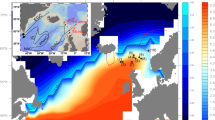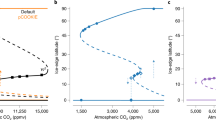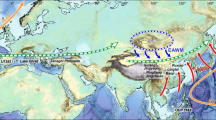Abstract
During the Last Glacial Maximum, tropical sea surface temperatures were 1 to 3 °C cooler than present1,2,3,4, but the altitude of the snowlines of tropical glaciers5,6 was lower than would be expected in light of these sea surface temperatures. Indeed, both glacial and twentieth-century snowlines seem to require lapse rates that are steeper than a moist adiabat7,8. Here we use estimates of Last Glacial Maximum sea surface temperature in the Indo-Pacific warm pool based on the clumped isotope palaeotemperature proxy in planktonic foraminifera and coccoliths, along with radiative–convective calculations of vertical atmospheric thermal structure, to assess the controls on tropical glacier snowlines. Using extensive new data sets for the region, we demonstrate that mean environmental lapse rates are steeper than moist adiabatic during the recent and glacial. We reconstruct glacial sea surface temperatures 4 to 5 °C cooler than modern. We include modern and glacial sea surface temperatures in calculations of atmospheric convection that account for mixing between rising air and ambient air, and derive tropical glacier snowlines with altitudes consistent with twentieth-century and Last Glacial Maximum reconstructions. Sea surface temperature changes ≤3 °C are excluded unless glacial relative humidity values were outside the range associated with deep convection in the modern. We conclude that the entrainment of ambient air into rising air masses significantly alters the vertical temperature structure of the troposphere in modern and ancient regions of deep convection. Furthermore, if all glacial tropical temperatures were cooler than previously estimated, it would imply a higher equilibrium climate sensitivity than included in present models9,10.
This is a preview of subscription content, access via your institution
Access options
Subscribe to this journal
Receive 12 print issues and online access
$259.00 per year
only $21.58 per issue
Buy this article
- Purchase on Springer Link
- Instant access to full article PDF
Prices may be subject to local taxes which are calculated during checkout




Similar content being viewed by others
References
CLIMAP Project Members, The surface of the ice age earth. Science 191, 1131–1137 (1976).
MARGO Project Members, Constraints on the magnitude and patterns of ocean cooling at the Last Glacial Maximum. Nature Geosci. 2, 127–132 (2009).
Lea, D., Pak, D. & Spero, H. Climate impact of Late Quaternary equatorial Pacific sea surface temperature variations. Science 289, 1719–1724 (2000).
De Garidel-Thoron, T. et al. A multiproxy assessment of the western equatorial Pacific hydrography during the last 30 kyr. Paleoceanography 22, PA3204 (2007).
Porter, S. Snowline depression in the tropics during the last glaciation. Quat. Sci. Rev. 20, 1067–1091 (2001).
Hastenrath, S. Past glaciation in the tropics. Quat. Sci. Rev. 28, 790–798 (2009).
Farrera, I. et al. Tropical climates at the Last Glacial Maximum: A new synthesis of terrestrial palaeoclimate data. I. Vegetation, lake-levels and geochemistry. Clim. Dynam. 15, 823–856 (1999).
Betts, A. & Ridgway, W. Tropical boundary layer equilibrium in the last ice age. J. Geophys. Res. 97, 2529–2534 (1992).
Braconnot, P. et al. Results of PMIP2 coupled simulations of the mid-Holocene and Last Glacial Maximum—part 1: Experiments and large-scale features. Clim. Past 3, 261–277 (2007).
Braconnot, P. et al. The Paleoclimate Modeling Intercomparison Project contribution to CMIP5. CLIVAR Exchanges 56, 15–19 (2011).
Braconnot, P. et al. Evaluation of climate models using palaeoclimatic data. Nature Clim. Change 2, 417–424 (2012).
Otto-Bliesner, B. et al. A comparison of PMIP2 model simulations and the MARGO proxy reconstruction for tropical sea surface temperatures at Last Glacial Maximum. Clim. Dynam. 32, 799–815 (2009).
Mathien-Blard, E. & Bassinot, F. Salinity bias on the foraminifera Mg/Ca thermometry: Correction procedure and implications for past ocean hydrographic reconstructions. Geochem. Geophys. Geosyst. 10, Q12011 (2009).
Beck, J. et al. Sea-surface temperature from coral skeletal strontium/calcium ratios. Science 257, 644–647 (1992).
Stute, M. et al. Cooling of tropical Brazil (5 °C) during the Last Glacial Maximum. Science 269, 379–383 (1995).
Xu, K. & Emanuel, K. Is the tropical atmosphere conditionally unstable?. Mon. Weath. Rev. 117, 1471–1479 (1989).
Barrows, T., Hope, G., Prentice, M., Fifield, L. & Tims, S. Late Pleistocene glaciation of the Mt Giluwe volcano, Papua New Guinea. Quat. Sci. Rev. 30, 2676–2689 (2011).
Prentice, M. & Glidden, S. in Altered Ecologies: Fire, Climate and Human Influence on Terrestrial Landscapes Vol. 32 (eds Haberle, S. G., Stevenson, J. & Prebble, M.) 457–471 (ANU EPress, 2010).
Hostetler, S. & Clark, P. Tropical Climate at the Last Glacial Maximum Inferred from Glacier Mass-Balance Modeling. Science 290, 1747–1750 (2000).
O’Gorman, P. & Muller, C. How closely do changes in surface and column water vapor follow Clausius–Clapeyron scaling in climate change simulations?. Environ. Res. Lett. 5, 025207 (2010).
Tripati, A. et al. 13C–18O isotope signatures and ‘clumped isotope’ thermometry in foraminifera and coccoliths. Geochim. Cosmochem. Acta 74, 5697–5717 (2010).
Reynolds, R. et al. An improved in situ and satellite SST analysis for climate. J. Clim. 15, 1609–1625 (2002).
Visser, K., Thunell, R. & Stott, L. Magnitude and timing of temperature change in the Indo-Pacific warm pool during deglaciation. Nature 421, 152–155 (2003).
Elderfield, H. et al. A record of bottom water temperature and seawater δ18O for the Southern Ocean over the past 440 kyr based on Mg/Ca of benthic foraminiferal Uvigerina spp. Quat. Sci. Rev. 29, 160–169 (2010).
Brown, R. & Zhang, C. Variability of Midtropospheric Moisture and Its Effect on Cloud-Top Height Distribution during TOGA COARE. J. Atmos. Sci. 54, 2760–2774 (1997).
Kuang, Z. & Bretherton, C. A Mass-Flux Scheme View of a High-Resolution Simulation of a Transition from Shallow to Deep Cumulus Convection. J. Atmos. Sci. 63, 1895–1909 (2006).
Holloway, C. & Neelin, J. Moisture vertical structure, column water vapor, and tropical deep convection. J. Atmos. Sci. 66, 1665–1683 (2009).
Prentice, M., Hope, G., Maryunani, K. & Peterson, J. An evaluation of snowline data across New Guinea during the last major glaciation, and area-based glacier snowlines in the Mt. Jaya region of Papua, Indonesia, during the Last Glacial Maximum. Quat. Inter. 138, 93–117 (2005).
Prentice, M. & Hope, G. in The Ecology of Papua (eds Marshall, A. J. & Beehler, B. M.) Climate of Papua. 177–195 2007).
Betts, A. & Miller, M. A new convective adjustment scheme. Part II: Single column tests using GATE wave, BOMEX, ATEX and arctic air-mass data sets. Q. J. R. Meteorol. Soc. 112, 693–709 (1986).
Acknowledgements
A.K.T. would like to thank L. Thompson, R. Alley, A. Carlson, F. Anslow, D. Cicerone, D. Lea, N. Meckler, T. Schneider, S. Bordoni, K. Emanuel, J. Adkins, T. Crowley, T. Merlis and H. Spero for discussions; S. Crowhurst, H. Elderfield, A. LeGrande, G. Schmidt and L. Yeung for discussion of this work and comments on an early draft of this manuscript; J. Booth and L. Booth for invaluable assistance with sample preparation; J. Eiler for access to his laboratory and discussion of the work; and T. de Garidel-Thoron for provision of published data from MD97-2138. A.K.T. acknowledges J-Y. Peterschmitt and J. Meyerson for assistance extracting climate model outputs and drafting figures, and the international modelling groups that participated in PMIP2 and CMIP5 for providing their model output for analysis. We thank C. Holloway for the entrainment calculation code. Support was provided to A.K.T. by NSF (CAREER award, EAR-0949191, ARC-1215551), DOE (DE-FG02-13ER16402), the Hellman Foundation, NERC, and the UCLA Division of Physical Sciences; to R.A.E. by NSF (ARC-1215551); and to J.D.N. by NSF (AGS-1102838), which supported S.S. Sounding data for the warm pool are from the DOE Atmospheric Radiation Measurement Climate Research Facility. Support for the NCEP2 (Twentieth Century Reanalysis Project) data set is provided by DOE and NOAA, and for the Reynolds Ocean Temperature Reanalysis Dataset is provided by NOAA. Sediment samples were obtained from the Ocean Drilling Program and CEREGE.
Author information
Authors and Affiliations
Contributions
A.K.T. designed the project and experiments, managed the project, measured most of the samples, guided the modern data analysis, adiabat calculations, initiated the collaboration with modellers, interpreted the results and wrote the manuscript with feedback from all authors. R.A.E. assisted with project design and measured some of the samples. D.P. and S.S. analysed the modern sounding data and conducted the radiative–convective equilibrium calculations under the supervision of J.D.N., J.L.M. and A.K.T. L.B. provided samples from MD97-2138.
Corresponding author
Ethics declarations
Competing interests
The authors declare no competing financial interests.
Supplementary information
Supplementary Information
Supplementary Information (PDF 1028 kb)
Supplementary Information
Supplementary Information (XLSX 68 kb)
Supplementary Information
Supplementary Information (ZIP 34308 kb)
Rights and permissions
About this article
Cite this article
Tripati, A., Sahany, S., Pittman, D. et al. Modern and glacial tropical snowlines controlled by sea surface temperature and atmospheric mixing. Nature Geosci 7, 205–209 (2014). https://doi.org/10.1038/ngeo2082
Received:
Accepted:
Published:
Issue Date:
DOI: https://doi.org/10.1038/ngeo2082
This article is cited by
-
Evolution of tropical land temperature across the last glacial termination
Nature Communications (2022)
-
Projections of the future disappearance of the Quelccaya Ice Cap in the Central Andes
Scientific Reports (2018)
-
Nonlinear climatic sensitivity to greenhouse gases over past 4 glacial/interglacial cycles
Scientific Reports (2017)
-
Correspondence between the ENSO-like state and glacial-interglacial condition during the past 360 kyr
Chinese Journal of Oceanology and Limnology (2017)
-
The Indo-Pacific Warm Pool: critical to world oceanography and world climate
Geoscience Letters (2016)



